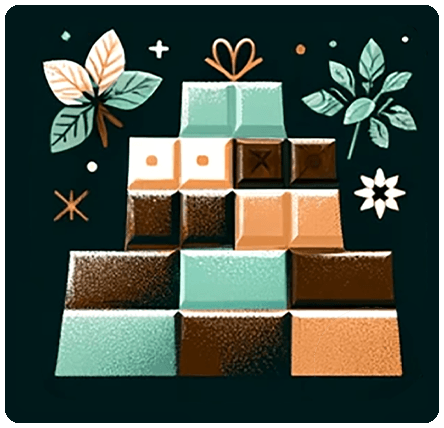Theobroma cacao trees originated in the Amazon rainforest about 5,300 years ago. The first societies, namely the Mayo-Chinchipe people from Ecuador, that grew and harvested Theobroma cacao for consumption in South America spread this knowledge to neighboring countries in Mesoamerica - a historical region linked by culture that spanned from present-day central Mexico down to El Salvador and Honduras.
The most prominent civilizations in Mesoamerica that developed a distinct and elaborative cacao culture were the Olmecs, the greater Maya Empire, and the Aztecs.
These early civilizations created cacao tree plantations. They also were the first to ferment, roast, and grind cacao beans into a powder or paste, which they used to make a frothy chocolate drink. Additionally, archeologists discovered that people in Mesoamerica ate cocoa, possibly as an ingredient or sauce for food.
Beyond their regular diet, archeological evidence and historical artifacts show that cacao and chocolate was highly valued and played a significant role in Mesoamerican creation mythology, religion, and everyday social culture.
![]()
Cacao Mythology in Mesoamerica
Cacao was such a significant part of Mesoamerica culture that the Olmecs, the greater Maya Empire, and the Aztecs incorporated cacao into their creation mythologies. They viewed cacao as a gift from the gods, so much so that scientist Carolus Linnaeus named the cacao tree Theobroma, which meant “food of the gods.”
The Olmecs and Mayans believed that the gods discovered cacao in the mountains. They enjoyed cacao and eventually shared it with mankind. The Mayan god Ek Chuah, who is their merchant god, was closely connected to cacao and chocolate. This underscores how highly valued cacao was in their culture as a commodity. They worshipped Ek Chuah with cacao offerings and depicted him in artifacts with cacao and chocolate.
Similarly, the Aztecs believed that the gods found cacao among other plants in the mountains. Their god Quetzalcoatl, who is their creator god from whom the Aztecs descended, was the one who shared cacao with mankind. The legend goes that Quetzalcoatl’s actions angered the other gods, and they exiled him. Before he left, Quetzalcoatl gifted mankind with the Theobroma cacao tree as a reminder that he would return one day. In 1521 CE, the legend contributed to the fall of the Aztecs when they eagerly welcomed conquistador Hernán Cortés believing he was their god Quetzalcoatl returning from exile.
Overall, Mesoamerican cacao culture believed cacao was a gift from the gods, and so cacao beans and the chocolate that was made from it was believed to possess powerful qualities.
How Were Cacao Beans Used in Mesoamerica
Cacao culture in Mesoamerica was extensive, influencing religion, medicine, commerce, and social customs. Below, we’ll break down some of the major ways in which cacao affected everyday life. Some of these cultural practices even carried over to Europe and North America as the knowledge of chocolate spread around the world.
CURRENCY
In Mesoamerica, people used cacao beans as currency. Cacao could be used to buy food, pay taxes, or even purchase a prostitute or slaves. For example, you could buy a turkey hen for 100 cacao beans or a slave for the same amount. A prostitute might cost somewhere between 8 to 10 beans. When trading, a rabbit would cost about 10 cacao beans, a pumpkin was 4 beans, and a tamale went for one bean. They also traded cacao beans for commodities like cloth, precious stones, and ceremonial feathers.
TRIBUTE
The Aztecs greatly valued cacao. It’s rumored that King Montezuma II would drink gallons of chocolate in a single feast. However, due to climate restrictions, the Aztecs were not able to grow Theobroma cacao where they lived, so they were forced to import cacao beans from other regions in Mesoamerica. When the Aztec armies conquered a region that had access to Theobroma cacao, they would require these conquered regions to pay taxes or tribute in the form of food, textiles, and cacao beans. This was how the Aztecs maintained a steady supply of cacao beans in their capital city of Tenochtitlan.
SOCIAL STATUS
At several archeological sites, researchers discovered the presence of cacao genetics in higher quality vessels. It appears that these vessels were specially designed and reserved for cacao. This supports the theory that access to cacao beans was an indication of social status. As a show of wealth and prominence, people in Mesoamerica owned special cacao vessels, called tecomates, and enjoyed cacao and chocolate at social gatherings. Oftentimes, chocolate drinks were a luxury item reserved for rulers, religious priests, and warriors at feasts and festivals.
HEALTH & MEDICINE
Cacao was believed to possess healing powers. Mesoamericans claimed that cacao gave you extra strength and increased libido. In early cacao culture, for medicine, the Olmecs would mix fermented pulp of the cacao fruit with cocoa powder and spices. Eventually, this drink was sweetened and used for non-medicinal purposes. Even so, the early belief that cacao could cure illnesses was adopted by the Spanish and other Europeans.
SEXUAL DRIVE
Mesoamerican cacao culture believed that chocolate was a strong aphrodisiac. The Aztecs claimed that chocolate gave men seductive powers, which could overpower any woman, and increased a man’s libido. For this reason, according to historical accounts, King Montezuma II and Aztec men consumed large amounts of chocolate during and after special feasts.
RITUALS
Cacao beans also played a role in significant religious and social rituals. It was used in Aztec human sacrifices - a piece of chocolate was given to those who were about to be sacrificed as consolation. Cacao beans functioned as dowries, played a role in wedding ceremonies in which the bride and groom would exchange five cacao beans, and as gifts during coming-of-age rituals for young men.
FUNERALS
In Mesoamerica, archeologists discovered special cacao vessels inside tombs and at burial sites. It’s suspected that cacao beans and cacao vessels played a role in the funerary services of these early civilizations. It’s likely that these vessels were so highly valued in Mesoamerican cacao culture that they wished to take these with them into the afterlife.











